
Hexanchus griseus
This large, deepwater shark is an example of significantly more primitive species found only as fossils. It has a broad, flat head, large green eyes, and a small, single dorsal fin far along its back. Average length is 15 to 16 feet long, and it is gray to olive to brown in color. It feeds nocturnally and ambushes its prey, but because it lives at depths, little is known about it and it is not considered a threat to humans unless it is provoked.
Order – Hexanchiformes
Family – Hexanchidae
Genus – Hexanchus
Species – griseus
Common Names
English language common names include bluntnose sixgill shark, Atlantic mud shark, brown shark, bull dog shark, bull shark, cow shark, gray shark, grey shark, mud shark, sixgill cow shark, sixgill shark, and sixgilled shark. Common names in other languages include albafar (Portuguese), albafara (Spanish), albafora (Portuguese), albajar (Spanish), aletra (Greek), altiyariklicanavar baligi (Turkish), arbano (French), bambakaris (Greek), bastruivaca (Spanish), bolquidolce (Spanish), bouche douce (French), boz baligi (Turkish), canhabota cinzenta (Portuguese), carcharias (Greek), chien de mer (Spanish), exacarcharias (Greek), gato de mar (Spanish), grauhai (German), griset (French), kagurazame (Japanese), kalb (Arabic), kamtannhai (Norwegian), kelb bhar (Arabic), kidushai (Finnish), marfara (Spanish), marrajo (Spanish), morruna (Maltese), notidan (German), olho-verde (Portuguese), pas glavonja (Serbian), pating (Tagalog), peix xovato (Spanish), pesce manzo (Italian), pesce mbove (Italian), peshkagen kokeshtypur (Albanian), qarsh (Arabic), rechin sur (Rumanian), requin riset (French), rotbraunhai (German), sechskiemer (German), seskiefhaai (Afrikaans), shez-zim (Hebrew), sliina nang gyuugings (Haida), squalo capopiatto (Italian), stierhai (German), szescioszpar (Polish), tatera (Maori), testa piatta (Italian), tiburon gris (Spanish), and tubarao-albafar (Portuguese).
Importance to Humans
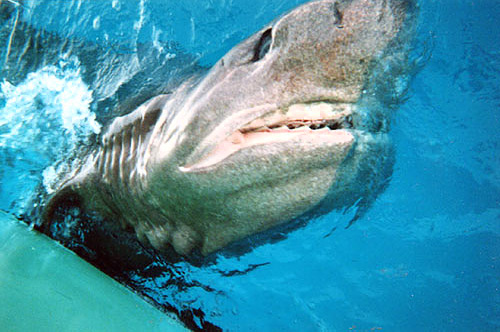
The bluntnose sixgill shark is fished both commercially and as a game fish throughout its range. It is caught with line gear, gillnets, traps, and trawls. The flesh is marketed fresh, frozen, and dried-salted. It is also utilized for oil and fishmeal.
Danger to Humans
This shark has not been reported to attack people without being provoked. According to the International Shark Attack File, there has been only one documented provoked attack on a human since the 1500s.
The bluntnose sixgill shark appears to be at ease in the presence of divers. However, it does not like to have physical contact or to be surrounded by humans and will swim off into deeper waters. It has been reported to snap when touched by divers and when caught by fishers. Care should be taken when landing this shark to avoid injury.
Conservation
> Check the status of the bluntnose sixgill shark at the IUCN website.
The IUCN is a global union of states, governmental agencies, and non-governmental organizations in a partnership that assesses the conservation status of species.
This species appears to be unable to sustain pressures from target fisheries and as bycatch which have led to the depletion of regional populations. However, due to a lack of population and fisheries data, the depletion of worldwide population levels has not been proven.
Geographical Distribution
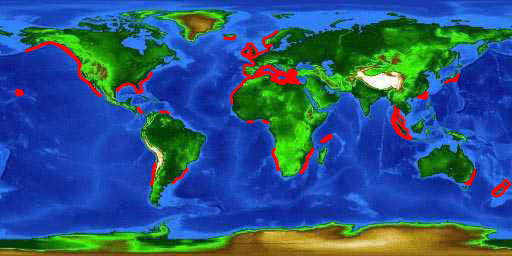
The bluntnose sixgill shark is one of the wider ranging sharks, residing in temperate and tropical seas around the world. In the western Atlantic Ocean, this range includes from North Carolina to Florida (US) and from the northern Gulf of Mexico to northern Argentina including Nicaragua, Costa Rica, and Cuba. In the eastern Atlantic, this shark is found from Iceland and Norway south to Namibia, including the Mediterranean Sea. Its range in the Indian Ocean includes off Madagascar and Mozambique. It also resides in the Pacific Ocean with distribution in the western Pacific from eastern Japan to Australia and New Zealand as well as out in Hawaiian waters. In the eastern Pacific, the bluntnose sixgill shark can has been documented in waters from the Aleutian Islands, Alaska south to Baja California, Mexico and Chile. This species is considered a highly migratory species according to the Annex I of the 1982 Convention on the Law of the Sea.
Habitat
This shark is primarily a deepwater species living over the outer continental and insular shelves as well as upper slopes. It rests along the bottom during the day to depths of 6,500 feet (2000 m), swimming close to the surface or moving into shallow waters at night to feed. The bluntnose sixgill shark is considered a slow but strong swimmer. Juveniles have been reported from waters close inshore.
Little is known about the behavior and migration habits of the bluntnose sixgill shark due to the depths at which its spends most of its life. However, this species is most often observed as a solitary shark.
Distinguishing Characteristics
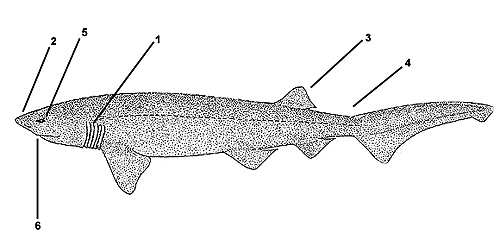
1. Six gill slits
2. Head is large and rounded to bluntly pointed
3. One dorsal fin present
4. Caudal peduncle is short and stout
5. Eye green in life
6. Six saw-like teeth on each side of the lower jaw and nine smaller, serrated, single-cusped teeth on each side of the upper jaw
Biology
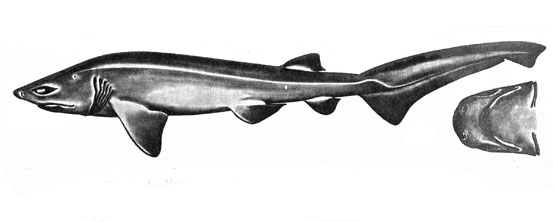
Distinctive Features
The bluntnose sixgill shark closely resembles fossil forms dating from the Triassic period (approximately 200 million years ago). This shark has a heavy fusiform body with a flattened, broad head. The rounded snout is blunt and there are six long gill slits on each side of the head, hence its common name, “bluntnose sixgill shark”. The ventrally located mouth is wide and broadly rounded. The large teardrop-shaped green eyes are found anterior to the mouth.
There is only one dorsal fin located close to the caudal fin. Its origin is adjacent or just behind the insertion point of the pelvic fins. The dorsal fin has a rounded apex and slightly convex rear margin. The pectoral fins have broad bases and rounded tips. The anal fin is small than the dorsal fin. The pelvic fins have close to straight margins and rounded tips. The caudal peduncle is short and stout and the ventral lobe of the caudal fin is not very pronounced with only moderate development.
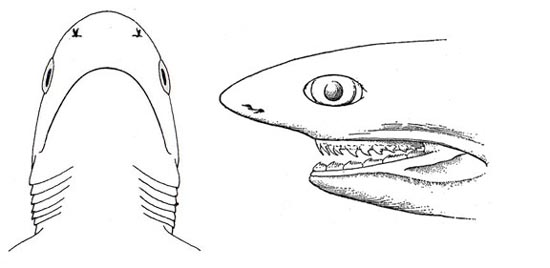
The single dorsal fin along with the six gill slits and teeth help to distinguish this shark from most other species. Most sharks have only five gill slits. One species that it is sometimes confused with is the bigeyed sixgill shark (Hexanchus vitulus). The bluntnose sixgill shark is much larger and has a blunt snout while the bigeyed sixgill shark is smaller and has a more pointed snout. Another species, the frill shark (Chlamydoselachus anguineus), may be mistaken for the bluntnose sixgillshark. However, the frill shark has fang-like teeth and six gill slits with gill covers that extend across the throat.
Coloration
The bluntnose sixgill shark is either gray, olive green or brown on the upper side, fading to a paler underside. There is a distinct light-colored stripe along each flank close to the lateral line. The fins may have pale edges. Living individuals have fluorescent green eyes.
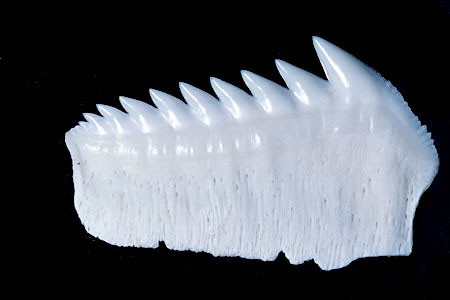
Dentition
A distinguishing character, the bluntnose sixgill shark has six broad, saw-like teeth on each side of the lower jaw. The upper jaw has nine smaller, serrated, single-cusped teeth on each side.
Denticles
Denticles of the bluntnose sixgill shark have three teeth with a defined axial crest and two lower crests. They are loosely to moderately-closely arranged with little overlapping. The denticles on the posterior of the caudal fin’s upper margin are larger, smooth and oval in shape.
Size, Age, and Growth
The maximum reported size for this species is a 15.8 feet (4.8 m) total length male individual. The maximum published weight is 1,300 pounds (590 kg). The average length of the bluntnose sixgill shark is approximately 16 feet (4.8 m). Males reach maturity at lengths of 10 feet (3 m) and 440 pounds (200 kg) while females mature at 13 feet (4 m) in length and 880 pounds (400 kg) in weight. Although age determination is difficult, it is suggested that the corresponding age when males reach maturity is 11-14 years and 18-35 years for females. Longevity for this species is thought to be 80 years.
Food Habits
The bluntnose sixgill shark feeds nocturnally on a wide variety of prey items. It consumes large bony and cartilaginous fishes such as dolphinfish, billfish, flounder, cod, hagfish, lampreys, chimaeras, and rays. Spiny dogfish (Squalus acanthias), longnose dogfish (Squalus blainvillei), shortnose dogfish (Squalus megalops), and prickly sharks (Echinorhinus cookei) are also consumed by the bluntnose sixgill shark.
Other prey includes small fishes, snails, crabs, shrimp, and squid. It also scavenges on the carrion of seals, sea lions, and whales as well as on bait from longlines set for other targeted fisheries.
This shark probably ambushes prey from a close range. Small prey items may be caught in the corner of the jaw with a sideways movement of the head. The teeth of the lower jaw suggest that the bluntnose sixgill shark saws the flesh from prey items that cannot be swallowed whole.
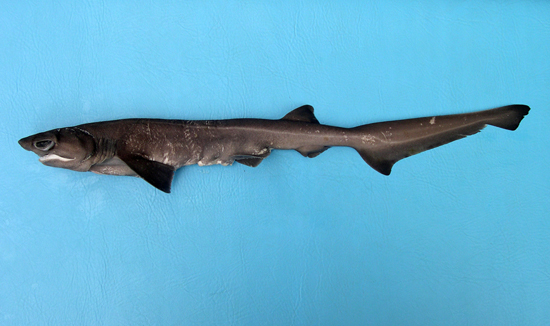
Reproduction
Reproduction in this shark occurs through ovoviparity; the eggs hatch inside the body with the embryos remaining in the female’s body until the end of gestation. After a long gestation period, a very large litter numbering from 22 to 108 is born. At birth, each pup measures about 23-30 inches (60-75 cm) in length. Although courtship and mating have not been observed, it is believed that the male gently grabs the female near the gills, pectoral fins and flanks as evidenced by the seasonal appearance of scars on the females.
Predators
Potential predators of the bluntnose sixgill shark may be Stellar’s sea lion (Eumetopias jubatus), killer whale (Orcinus orca), and the white shark (Carcharodon carcharias).
Parasites
The acanthocephalans Corynosoma australe and Corynosoma sp. have been documented in the spiral valve of the bluntnose sixgill shark. Parasitic copepods, including Pandarus bicolor, have also been reported on the fins and head of this shark. Two nematode species, Anisakis sp. and Contracaecum sp., have been reported as parasites of this shark.
Taxonomy
Originally described as Squalus griseus by Bonnaterre in 1788, the bluntnose sixgill shark went through a series of names before the currently valid name was determined. Scientific names including Notidanus griseus and Monopterinus griseus were used to describe this species prior to the valid name Hexanchus griseus (Bonnaterre 1788). The genus name Hexanchus is derived from the Greek “exa” meaning six and “ankos” meaning gill. The species name griseus is derived from Latin, meaning gray. Synonyms used in previous scientific literature that refer to this species includeSqualus vacca Bloch & Schneider 1801, Notidanus monge Risso 1827, Hexanchus corinum Jordan & Gilbert 1880, Hexanchus corinus Jordan & Gilbert 1880, Notidanus vulgaris Perez Canto1886, and Hexanchus griseus australis de Buen 1960.
Prepared by: Cathleen Bester